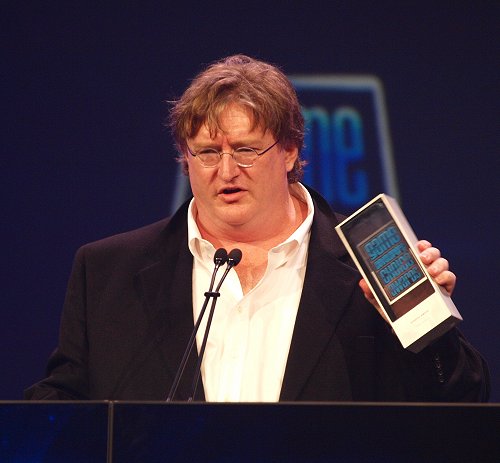

Source: Official GDC
Valve is shifting away from Windows and will soon reveal its GNU/Linux appliance [1-10], which will be a gaming machine. Intel, the largest chipmaker, is meanwhile showing increasing levels of support for GNU/Linux leaders [11] (except Canonical's forks with Ubuntu [12]) in order to sell chips on devices [13-14], desktops/laptops [15], and servers [16]. There is clearly a lot of work going into kernel-level improvements [17-20] and Intel now foresees a future of GNU/Linux as the dominant desktop platform [21-22]. Given that even allies of Microsoft (or former staff-turned-entrepreneur with net worth of $ 1.1 billion) switch to GNU/Linux so enthusiastically, can anyone still say with a straight face that GNU/Linux will never "make it"? ⬆
Valve are making another Linux push towards having their full library available on Linux, this time it's Half-Life: Source & Half-Life Deathmatch: Source.
Running With Scissors has revealed some but not all of the details of what will come with the Postal 2 (Steam, Desura) DLC!
Gabe Newell, CEO of Valve declared that proprietary software and closed platforms are gaming's past, its future is open and on Linux.
For those that didn't yet watch Gabe Newell's talk about Linux gaming, at the end of the presentation he notes next week will be more information from Valve about their plans to bring Linux into the living room.
Valve chief blasts PC market, promises big news is coming next week.
Gabe Newell was one of the prominent speakers today during the first day of LinuxCon in New Orleans. Here's an upload of his presentation where he's trumpeting the benefits of Linux for servers and gaming. Gabe believes, "Linux is the future of gaming."
Linux is landing on gaming systems and embedded devices, but challenges still remain as leading technology thinkers detail the state of Linux at the LinuxCon conference.
The gamers among us waited... very... patiently... for Steam to come to Linux. This week, Valve co-founder Gabe Newell came to LinuxCon to talk about Linux, gaming, and how important open source is to the future of gaming, which given the audience, he described as "sort of like going to Rome and teaching Catholicism to the Pope." In even better news, he also strongly hinted at a Steam Box announcement next week.
Open Source is all about collaboration and contribution and two leading communities are working towards making Wayland a reality.
As a major set-back to Canonical's plans for Mir, Intell has pulled the carpet from underneath Canonical by announcing that they won't support XMir.
EMAC announced a fanless, Linux-ready PC/104 format single-board computer built around Intel’s 1.6GHz Atom N270 processor, available in a wide temperature (-40 to 80€°C) model.
Acrosser announced a Fedora Linux-ready Mini-ITX single board computer (SBC) equipped with a dual-core 1.86GHz Intel Atom D2550. The AMB-D255T3 supports up to 4GB of DDR3 RAM, can run dual displays via VGA, HDMI, or 18-bit LVDS interfaces, and offers both PCI and Mini-PCIe expansion.
Intel and Google have announced new Chromebooks powered by the much talked about Haswell processors. Two major PC vendors ASUS and Toshiba have joined the Chrome OS club which include Samsung, Acer and HP. While HP and Acer are offering new Chromebooks, ASUS is brining new Chromebox to the market.
At LinuxCon, Dirk Hohndel, Intel's chief Linux and open-source technologist, explains why Intel is invested in open source and what his company is doing with the OpenStack cloud.
It's been a while since last hearing anything from Intel engineers about their proposed Power Capping Framework or Running Average Power Limit driver for the Linux kernel, but that changed today. New patches have been released for the power monitoring and limiting kernel code.
Last week I ran a System76 Galago UltraPro Preview with some benchmark results and a special article looking at the Intel Iris Pro 5200, the Haswell graphics cores with 128MB of dedicated video memory stacked onto the die itself. Those tests were done remotely but now with having a System76 Galago UltraPro ultrabook review sample in the labs, here are some fresh tests looking at the very latest state of Haswell Iris Pro graphics under Linux. The benchmarks cover the state of Ubuntu 13.04 going through the latest open-source Linux graphics driver code with the yet-to-be-released Mesa 9.3 and the Linux 3.12 kernel.
For the past few days at Phoronix we have begun looking extensively at the Intel Iris Pro 5200 graphics under Linux, since receiving the System76 Galago UltraPro. The Iris Pro 5200 are the new high-end Intel Haswell graphics that have 128MB of embedded video RAM on the die, which should yield a nice performance boost when properly implemented within the Intel Linux driver. Already our testing has found the Iris Pro performance on Linux has doubled with open-source driver improvements since Haswell's launch. Now we're out today with our first Intel Iris Pro OpenGL gaming benchmarks between Ubuntu Linux and Microsoft Windows 8 for this Intel Core i7 Ultrabook.
Intel's Ian Romanick will take to the Linux Plumbers Conference tomorrow with a plea to work together to provide better capabilities across the Linux stack for better debugging and profiling of graphics applications/systems on Linux. The open-source Intel Linux Mesa developer himself calls the current graphics debugging situation on Linux a "disaster" to be fixed.
Today in Open Source: Intel thinks the year of the Linux desktop is here. Plus: Linus and Moore's Law, and Tiny Core 5.0 screenshots
New Orleans: The Sept. 18 LinuxCon keynote sessions were kicked off by Intel Chief Linux and Open Source Technologist and Linux kernel developer Dirk Hohndel who said that client computing today is mostly Linux. Thanks to Android on smartphones and tablets, plus the rise of Chromebooks, Intel sees Linux as the leading end-user operating system.